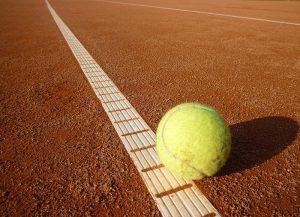We may earn money or products from the companies mentioned in this post.
Introduction

Playing tennis is a thrilling and competitive sport that requires skill, strategy, and adaptability Within the world of tennis, there are various playing styles that players adopt to gain an advantage over their opponents One such style is known as the “pusher” In this article, we will explore what it means to be a pusher in tennis, examining their defensive playing style and the unique characteristics and tactics they employ on the court
Definition of a Pusher in Tennis
In tennis, a pusher refers to a player who adopts a predominantly defensive playing style Unlike aggressive players who seek to overpower their opponents with powerful shots and winners, pushers rely on consistency and precision to frustrate their adversaries They prioritize keeping the ball in play rather than going for risky shots
1 Defensive Playing Style
A pusher’s primary focus is on retrieving every ball that comes their way, often using deep groundstrokes or slice shots to keep the ball low and force errors from their opponents Their goal is to extend rallies by returning difficult shots with accuracy, patience, and tenacity
2 Characteristics and Tactics Used by Pushers
Pushers are known for their exceptional court coverage skills They possess quick footwork and agility which allows them to track down even seemingly impossible shots Additionally, they have excellent anticipation abilities that enable them to read their opponent’s moves effectively
In terms of tactics, pushers tend to exploit their opponents’ weaknesses by consistently hitting high-percentage shots aimed at areas where they struggle most They utilize lobs and drop shots strategically to disrupt their opponent’s rhythm while also employing well-placed angles to create openings for themselves
The Importance of Understanding How to Beat a Pusher
When faced with a pusher on the court, it is crucial for players to understand how to counter their defensive tactics effectively This understanding not only enhances overall game strategy but also helps overcome the mental challenges associated with playing against pushers
1 Enhancing Overall Game Strategy
By learning how to beat a pusher, players can develop a more well-rounded game strategy They can incorporate tactics that exploit the weaknesses of pushers, such as utilizing aggressive shots and attacking the net when appropriate This adaptability allows players to take control of matches and dictate the pace
2 Overcoming Mental Challenges Associated with Playing Against Pushers
Playing against pushers can be mentally taxing as they test a player’s patience and consistency Understanding how to beat them helps players stay focused and confident in their abilities It enables them to approach matches against pushers with a positive mindset, knowing that they have the tools to outmaneuver their opponents and secure victory
Identifying the Weaknesses of a Pusher

A pusher in tennis may pose a challenge on the court, but their style of play also comes with its own set of weaknesses By understanding these weaknesses, you can develop effective strategies to counter their game and gain the upper hand Let’s explore some key vulnerabilities of pushers:
Limited offensive capabilities
Pushers often struggle when it comes to generating powerful shots or aggressive play This opens up opportunities for you to take control of the match
-
a) Exploiting weak shots:
Look for moments when the pusher’s shots lack pace or depth Use this opportunity to seize control and dictate the pace of the rally -
b) Targeting weaker strokes (backhand, forehand):
Pushers tend to have one or more weaker strokes Identify these areas and direct your shots towards them, putting them under pressure
Inconsistent net play
Pushers are not typically comfortable at the net, which can be advantageous for you if you exploit this weakness effectively
-
a) Forcing them to the net:
Employ drop shots and short balls that force the pusher out of their comfort zone and into a vulnerable position near the net -
b) Approaching the net yourself:
By confidently moving towards the net, you can put pressure on their passing shots and force them into making errors
Stamina and fitness levels
Pushers often rely on consistent baseline rallies, but their stamina and fitness levels may falter over time
-
a) Wearing them down physically:
Engage in long rallies, making the pusher cover more ground and expend energy This can lead to fatigue and a subsequent drop in their performance -
b) Strategic shot placement:
Aim for shots that force the pusher to move laterally or diagonally, causing them to exert more effort and drain their stamina
Developing an Effective Game Plan Against Pushers

Now that you have identified the weaknesses of a pusher, it’s essential to create a game plan that exploits these vulnerabilities Here are some key strategies:
Adapting your playing style and mindset
-
Embracing patience during rallies:
Pushers excel at extending points, so maintaining composure and not rushing into unforced errors is crucial -
Staying focused and avoiding frustration:
Pushers aim to frustrate opponents with consistent play Stay mentally strong, avoid getting flustered, and stick to your game plan
Taking control of points early on
-
Aggressive serves and returns:
Start points with powerful serves or returns, pushing the pusher onto the defensive right from the beginning -
Utilizing angles and depth to destabilize their position:
Vary your shots by hitting deep balls that stretch them out wide or incorporating angled shots to disrupt their positioning
In part II of this article series “Implementing Specific Strategies for Success Against Pushers in Tennis,” we will delve further into precise tactics that can help you overcome pushers on the court Stay tuned!
Useful Links

Beating a Pusher
Tactical Tennis: Playing the runner-pusher
I Was A Pusher For Years. Here Is How to Beat a Pusher
Distance Learning with Paul & Prakash: How to beat a …
The Pusher’s Strategy is Better Than Yours
6 Great Tips on How to Beat a Pusher in Tennis
How to Beat a Tennis Lobber (aka, the Pusher …
5 Ways to Beat a Pusher – Tennis – ACTIVE
Beating pushers – Drills and Strategies
How to Play and Beat a Tennis Pusher
How To Beat Pushers
How to Beat a Pusher or Moonballer in Tennis?
Beat a Pusher
What is a Pusher in Tennis?
How to Beat a Pusher –
Tennis Tip: 5 Ways to Beat a Pusher
Tactics for beating a pusher
How to beat a pusher – Tom Lodziak Table Tennis Coaching






